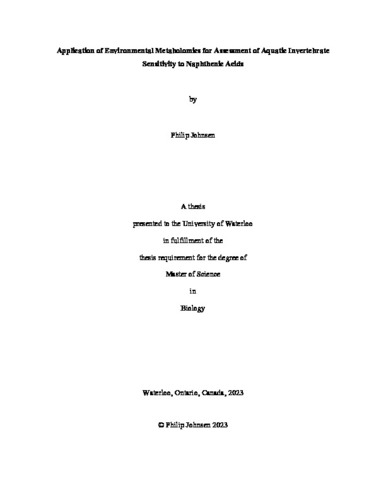| dc.contributor.author | Johnsen, Philip | |
| dc.date.accessioned | 2023-12-14 20:04:37 (GMT) | |
| dc.date.available | 2023-12-14 20:04:37 (GMT) | |
| dc.date.issued | 2023-12-14 | |
| dc.date.submitted | 2023-12-04 | |
| dc.identifier.uri | http://hdl.handle.net/10012/20165 | |
| dc.description.abstract | Naphthenic acids (NAs) are a class of chemicals found in oil sands process waters (OSPW) from the extraction of bitumen from surface mined oil sand. In Alberta, Canada, OSPW is currently stored indefinitely in tailing ponds and there are environmental concerns about seepage or spillage. NAs are known to be toxic to aquatic organisms. However, NA toxicity data are limited to primarily acute effects in a few species. Due to difficulties in comparing NA toxicity results, an extracted solution referred to as naphthenic acid fraction components (NAFCs) can be used as it is representative of OSPW toxicity and is well characterized. The goal of this research is to inform NA standards by performing chronic toxicity tests to derive metabolomic responses and estimates of survival. I exposed the ramshorn snail (Planorbarius corneus), and nymphs of two dragonflies, the common whitetail (Plathemis lydia) and the eastern pondhawk (Erythemis spp.), to 0, 6, 12, and 25 mg/L NAFCs for 21-days (snails) or 14-days (dragonflies) in laboratory microcosm experiments. Survival was altered only in the common whitetail with NAFC exposure. Snails laid approximately double the number of egg masses at higher concentrations of NAFCs. The metabolome responded differently among taxa. NAFC exposure altered the metabolome of only the common whitetail. Metabolite analysis for the common whitetail found that most altered metabolites were amino acids. The identified metabolites were involved primarily in pathways related to energy metabolism and protection from oxidative stress. My findings indicate that sensitivity to NAFCs is taxon-specific and demonstrate that an organism’s metabolome can provide insight into toxic effects of NAFCs. | en |
| dc.language.iso | en | en |
| dc.publisher | University of Waterloo | en |
| dc.subject | naphthenic acids | en |
| dc.subject | metabolomics | en |
| dc.subject | environmental metabolomics | en |
| dc.subject | toxicology | en |
| dc.subject | oil sand process waters | en |
| dc.title | Application of Environmental Metabolomics for Assessment of Aquatic Invertebrate Sensitivity to Naphthenic Acids | en |
| dc.type | Master Thesis | en |
| dc.pending | false | |
| uws-etd.degree.department | Biology | en |
| uws-etd.degree.discipline | Biology | en |
| uws-etd.degree.grantor | University of Waterloo | en |
| uws-etd.degree | Master of Science | en |
| uws-etd.embargo.terms | 0 | en |
| uws.contributor.advisor | Yates, Adam | |
| uws.contributor.affiliation1 | Faculty of Science | en |
| uws.published.city | Waterloo | en |
| uws.published.country | Canada | en |
| uws.published.province | Ontario | en |
| uws.typeOfResource | Text | en |
| uws.peerReviewStatus | Unreviewed | en |
| uws.scholarLevel | Graduate | en |

